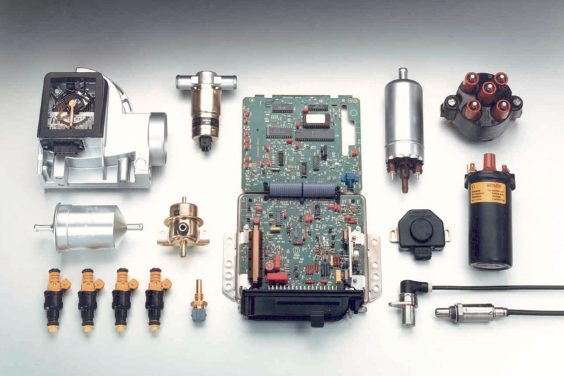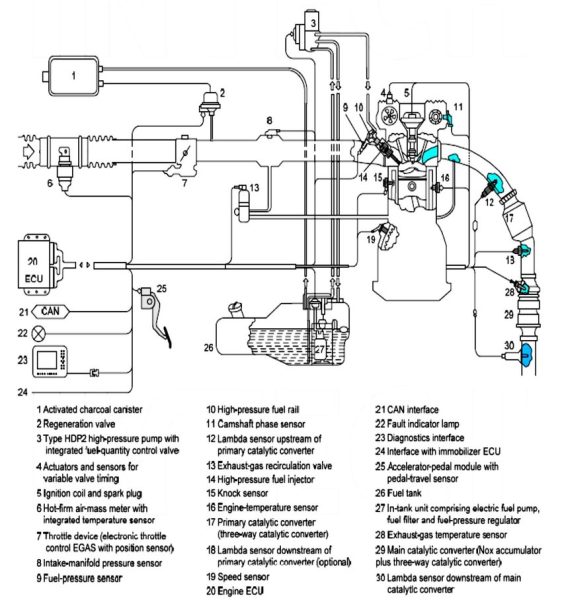In the world of modern automobiles, fuel injection and ignition components play a critical role in making an engine run smoothly and efficiently. One of the earliest fuel injection and ignition systems was the Motronic system, which was developed by Bosch in the 1970s. This system was used in many European cars, including BMW, Volkswagen, and Porsche, and helped usher in a new era of performance and efficiency in automotive engineering.
Fuel Injection Components:
The Motronic system was a type of electronic fuel injection (EFI) system, which replaced the older carburetor-based systems of earlier cars. The Motronic system consisted of several key components that worked together to deliver fuel to the engine.
The first component was the fuel injector, which was responsible for delivering fuel to the engine. The injector was controlled by the Motronic system’s electronic control unit (ECU), which monitored various engine parameters such as air flow, temperature, and throttle position to determine how much fuel to deliver to the engine.
The second component was the fuel pressure regulator, which ensured that the fuel delivered to the engine was at the correct pressure. The regulator was also controlled by the ECU and adjusted the fuel pressure based on engine conditions.
The third component was the air flow sensor, which measured the amount of air entering the engine. This information was used by the ECU to determine how much fuel to inject into the engine.
Ignition Components:
The Motronic system also included ignition components that worked in conjunction with the fuel injection system to deliver precise ignition timing to the engine. The ignition components included:
The distributor: This component was responsible for distributing high voltage electrical energy to the spark plugs in the correct sequence. The distributor was controlled by the ECU and adjusted the ignition timing based on engine conditions.
The ignition coil: The coil was responsible for generating the high voltage electrical energy needed to create a spark at the spark plug. The coil was also controlled by the ECU and adjusted the ignition timing based on engine conditions.
The spark plugs: The spark plugs were responsible for igniting the fuel in the engine’s cylinders. The spark plugs were designed to work with the Motronic system’s precise ignition timing to ensure optimal engine performance.

Conclusion:
The Motronic system was one of the earliest fuel injection and ignition systems used in modern automobiles. It relied on several key components, including fuel injectors, a fuel pressure regulator, an air flow sensor, a distributor, an ignition coil, and spark plugs, to deliver precise amounts of fuel and ignition timing to the engine. This system helped usher in a new era of performance and efficiency in automotive engineering and paved the way for future fuel injection and ignition systems.
Fuel Injection Components:
Fuel Injector: The fuel injector was a critical component of the Motronic system, responsible for delivering precisely-metered amounts of fuel to the engine’s combustion chambers. The fuel injector itself was a small, electrically-actuated valve that opened and closed very rapidly to allow fuel to be injected into the engine. The amount of fuel delivered was controlled by the Motronic system’s electronic control unit (ECU), which monitored a variety of engine parameters such as air flow, temperature, and throttle position to determine the optimal fuel delivery rate.
Fuel Pressure Regulator: The fuel pressure regulator was another important component of the Motronic system, responsible for maintaining a consistent fuel pressure within the fuel injection system. This was critical because the fuel injector needed to deliver fuel at a precise pressure in order to function properly. The regulator was controlled by the ECU and adjusted the fuel pressure based on engine conditions.
Air Flow Sensor: The air flow sensor measured the amount of air entering the engine, which was used by the ECU to determine how much fuel to inject. The air flow sensor was typically a type of hot wire sensor that was heated by an electrical current. As air flowed past the wire, it would cool it down, which changed its resistance. The ECU would measure the change in resistance and use that information to calculate the amount of air flowing into the engine.
Ignition Components:
Distributor: The distributor was a mechanical component that was responsible for distributing high voltage electrical energy to the spark plugs in the correct sequence. The distributor consisted of a rotor that rotated inside a cap that had metal contacts corresponding to each cylinder. As the rotor turned, it would make contact with the appropriate contact in the cap, which would then deliver a high voltage electrical spark to the spark plug. The distributor was controlled by the ECU and adjusted the ignition timing based on engine conditions.
Ignition Coil: The ignition coil was a critical component of the ignition system, responsible for generating the high voltage electrical energy needed to create a spark at the spark plug. The coil consisted of two sets of wire windings, a primary winding and a secondary winding. When the ECU sent a signal to the coil, it would create a magnetic field that would induce a high voltage spark in the secondary winding, which would then be sent to the appropriate spark plug.
Spark Plugs: The spark plugs were the final component of the ignition system, responsible for igniting the fuel in the engine’s cylinders. The spark plugs were designed to work with the Motronic system’s precise ignition timing to ensure optimal engine performance. The spark plug consisted of a metal shell with a ceramic insulator, which housed a central electrode and a ground electrode. When the high voltage electrical spark was delivered to the spark plug by the distributor and ignition coil, it would jump between the two electrodes, igniting the fuel in the cylinder.
In conclusion, the Motronic system was a sophisticated electronic fuel injection and ignition system that relied on precise control of fuel delivery and ignition timing to optimize engine performance. The system consisted of a variety of components that worked together to ensure that the engine received the right amount of fuel and spark at the right time, resulting in improved fuel efficiency and better performance.
Advantages:
- Improved Fuel Efficiency: The Motronic system was able to deliver precise amounts of fuel to the engine based on real-time data from a variety of sensors, resulting in improved fuel efficiency and reduced emissions.
- Better Engine Performance: The Motronic system allowed for precise control of the engine’s fuel delivery and ignition timing, resulting in better engine performance and smoother operation.
- Increased Reliability: The Motronic system was a more reliable and durable system compared to traditional carbureted engines, which were prone to issues such as vapor lock and carburetor icing.
- Reduced Maintenance Costs: The Motronic system was designed to be low-maintenance, with fewer components to replace and longer service intervals than traditional carbureted engines.
Disadvantages:
- Complexity: The Motronic system was a complex system that relied on sophisticated electronics and sensors to function properly. This complexity made the system more difficult to diagnose and repair, which could lead to increased maintenance costs.
- Higher Cost: The Motronic system was more expensive to produce and install than traditional carbureted engines, which could make it more difficult for some consumers to afford.
- Dependence on Electronics: The Motronic system was heavily dependent on electronic components such as the ECU and sensors, which could be vulnerable to electrical problems or failures.
- Limited Modification Options: The Motronic system was designed to be a closed system, which made it difficult for consumers to modify or upgrade the system without specialized knowledge and tools.
In conclusion, while the Motronic system offered many advantages over traditional carbureted engines, it was also more complex and expensive. As with any complex system, there were also potential disadvantages to consider, such as increased maintenance costs and limited modification options. However, overall the Motronic system represented a significant advance in automotive technology and helped to pave the way for the advanced electronic engine management systems we see in cars today.










